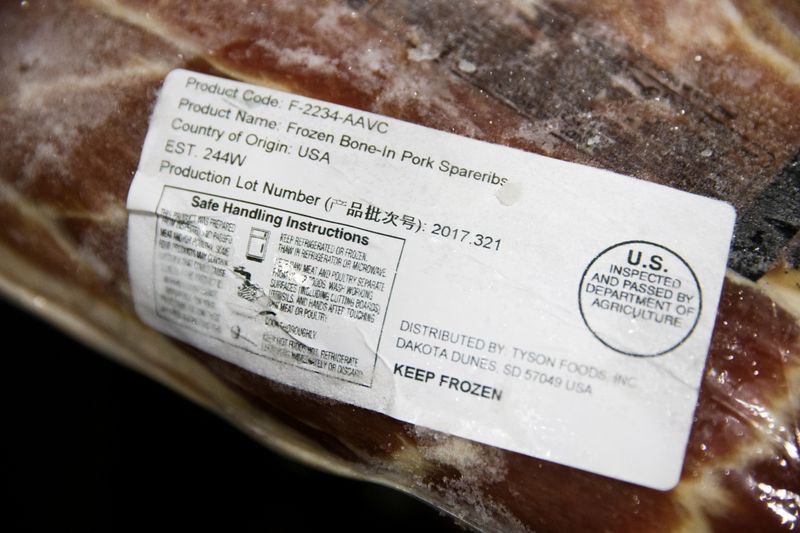By Karl Plume and Hallie Gu
CHICAGO/BEIJING (Reuters) - Days before a U.S.-China trade deal is due to be signed, large Chinese purchases of Brazilian soybeans and a pair of unexpected policy moves by Beijing have dimmed U.S. hopes that China would double its imports of American farm products this year.
U.S. President Donald Trump has touted the prospect of China buying $40 billion in U.S. farm products in 2020 as a pillar of the "Phase 1" agreement aimed at defusing the bitter trade war that erupted between the world's two largest economies in 2018.
The conflict, marked by tit-for-tat tariffs, has disrupted the flow of billions of dollars in goods and threatened to slow global growth, rattling financial markets. It has also sent a chill through the U.S. farm community, a key political constituency for Trump as he seeks re-election in November.
China announced on Thursday that Chinese Vice Premier Liu He, who has led Beijing's delegation in the trade talks with the United States, would sign the Phase 1 deal in Washington next week.
But Chinese forward purchases of Brazilian soybeans, including about a dozen bulk vessels this week, or about 800,000 tonnes, are raising doubts Chinese buyers will have an appetite for vast supplies of U.S. soybeans once the deal is done.
Margins in China for crushing raw soybeans into livestock feed and cooking oil have improved for mid-2020, the height of Brazil's soy export season, according to two China-based traders.
China's import needs have already been covered through the first quarter of the year, the traders said on condition of anonymity.
"The key factor for crushers is whether the beans are cheap, even with a trade deal. If the beans from South America are cheap, buyers will go for South America," one of the traders said.
No details about the targeted $40 billion shopping list have been published, and China has not confirmed any purchase commitment. The U.S. grain and livestock market rally that followed the Dec. 13 announcement of a trade deal has faded.
Adding to U.S. concerns about the deal, sources in China told Reuters this week that Beijing has suspended its plan to implement a nationwide gasoline blend containing 10% ethanol this year. The plan had spurred hopes of a jump in U.S. exports of the biofuel to China, as well as shipments of U.S. corn to produce it domestically.
The news that China's ethanol demand would not be rising broke a day after Beijing said it would not raise a low-tariff grain import quota to accommodate greater U.S. exports.
Gao Feng, spokesman at China's commerce ministry, said on Thursday that China will continue to improve the administration of tariff quotas for wheat, corn and soybeans in accordance with World Trade Organization commitments, and will make full use of quotas based on market conditions.
China could still expand agricultural imports from the United States, he said.
Even so, market observers question whether the United States' $40 billion goal can be reached without large volumes of a wide array of goods.
"Such a lofty target makes (the market) very skeptical about the whole thing," said Ted Seifried, chief strategist with Chicago-based brokerage Zaner Ag Hedge. "If China's going to hit these numbers or get anywhere close, ethanol will have to be part of the mix."
(GRAPHIC: JCI estimates of China's Phase 1 purchases of U.S. farm goods - https://fingfx.thomsonreuters.com/gfx/ce/7/7987/7969/JCIPhase1EstimatesJan2020.png)
STIFF COMPETITION
Chinese buying of most U.S. farm goods in recent weeks has remained well below the levels prior to the trade war, including for soybeans, the top U.S. farm export.
Soybean purchase commitments for the current U.S. crop stood at about 11 million tonnes as of Dec. 26, compared with about 24.5 million at the same point in 2017, according to the latest U.S. Department of Agriculture (USDA) data.
U.S. suppliers will continue to face stiff competition from a likely record-large Brazilian soybean crop, which farmers will begin harvesting in the coming weeks.
U.S. pork exports have been a brighter spot recently, rising to record highs late last year as China struggled with the loss of about half of its domestic hog herd to outbreaks of African swine fever, a fatal pig disease. U.S. pork sales through November totaled just over $1 billion, but continued buying at the recent pace could put annual purchases at around $2 billion.
Poultry meat exports, which peaked at nearly $722 million per year a decade ago, have languished in recent months. But China's demand for meat to supplement its pork shortage could eventually boost annual buying to between $1 billion and $2 billion, according to analysts.
Chinese consultancy JCI last month laid out its vision for fulfilling the $40 billion target by projecting record-shattering imports of nearly every importable farm commodity, some at prices well above current levels. But the group said its projections hinged on factors like prices and quality that are "favorable for China's purchase."
Others are more cautious.

"It is more likely for China to hit this annual target over the next three to five years rather than over the next two years," said Arun Sundaram, equity analyst with CFRA Research, who is projecting Chinese purchases of U.S. farm products at $15 billion to $20 billion this year.